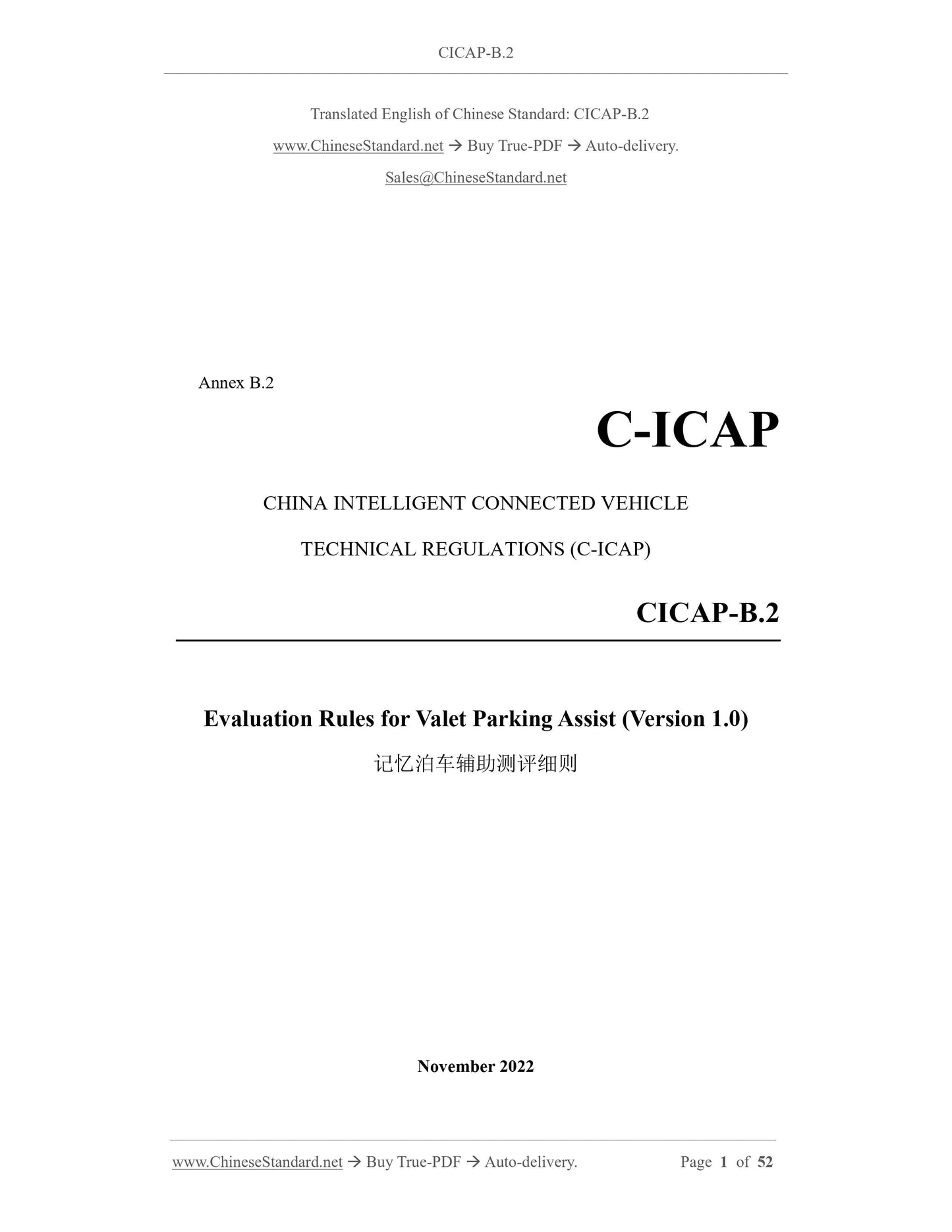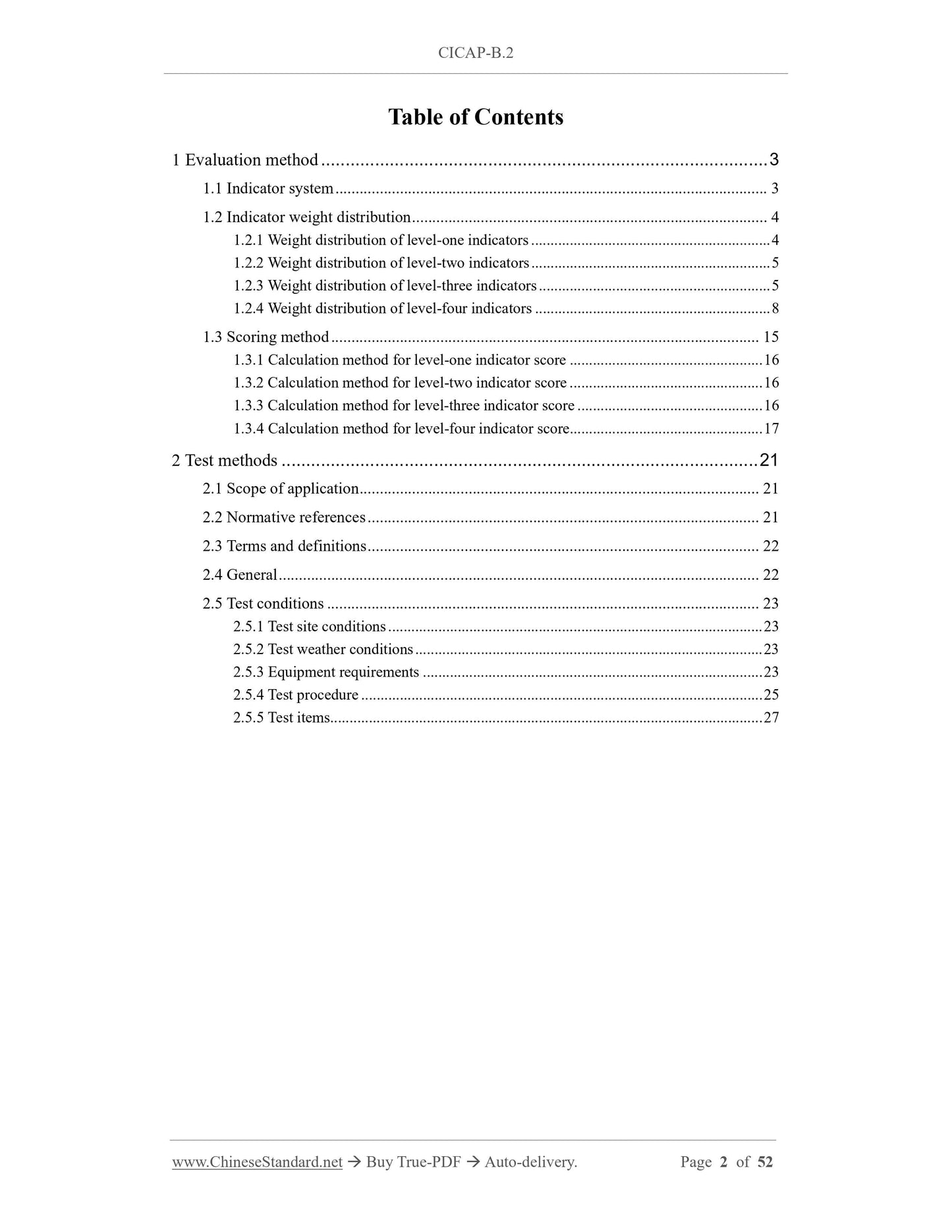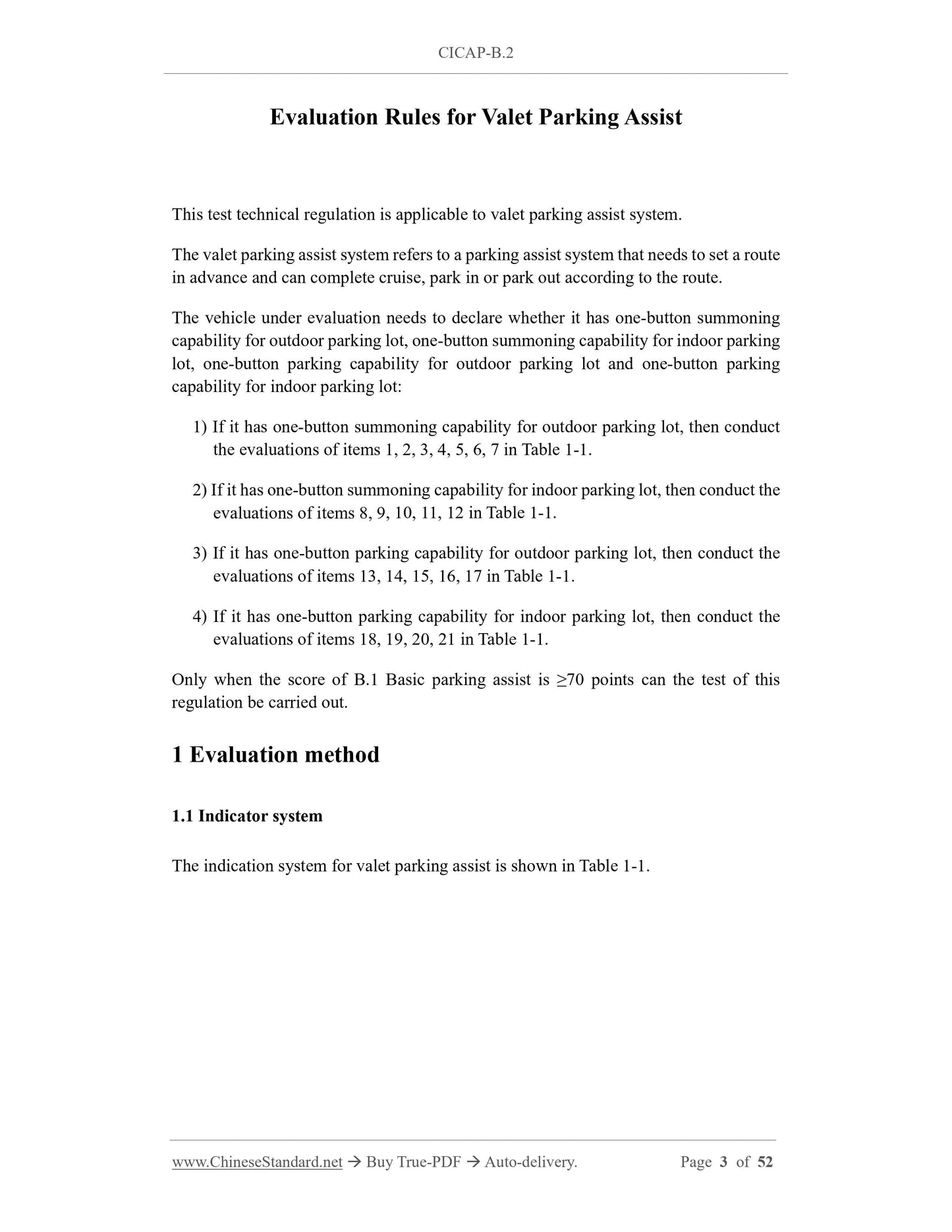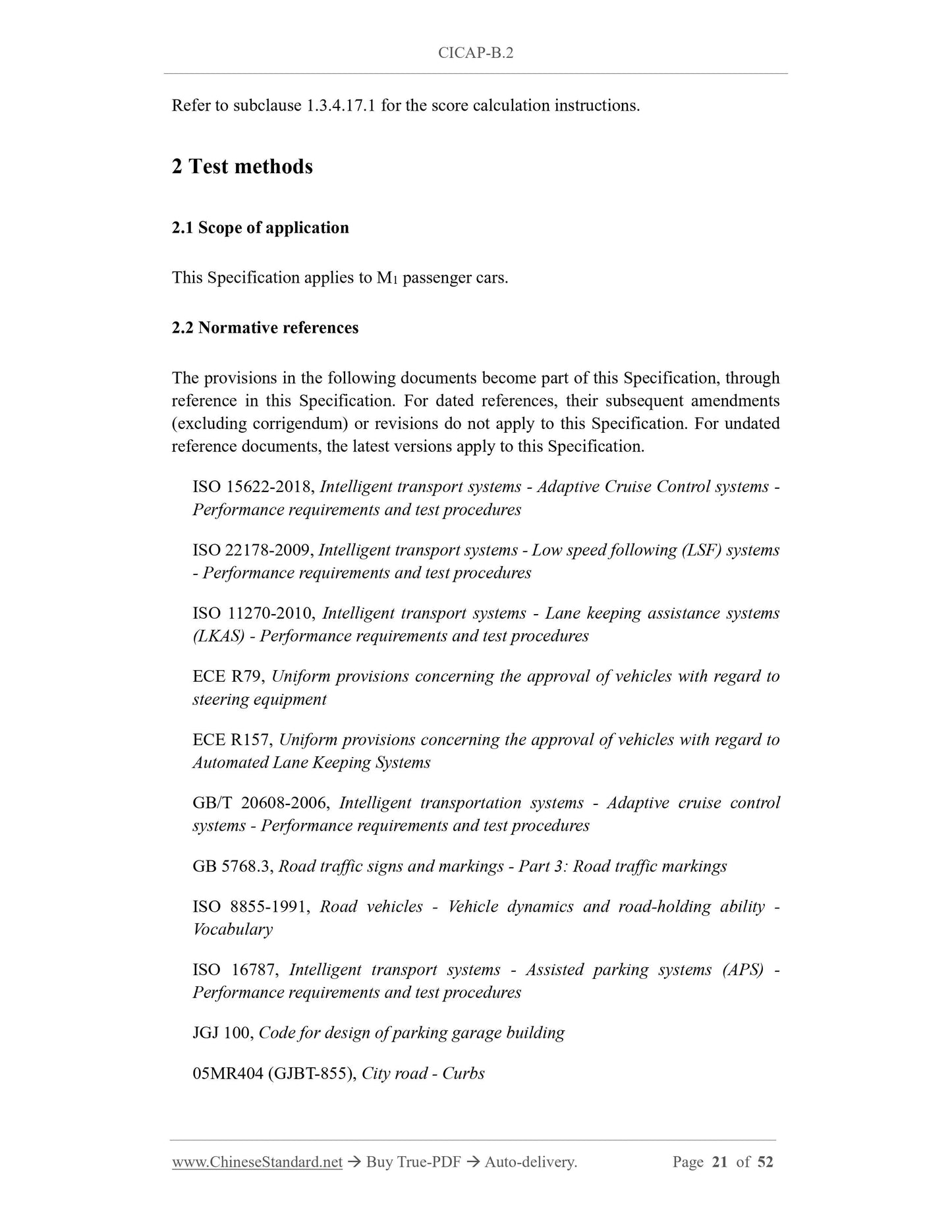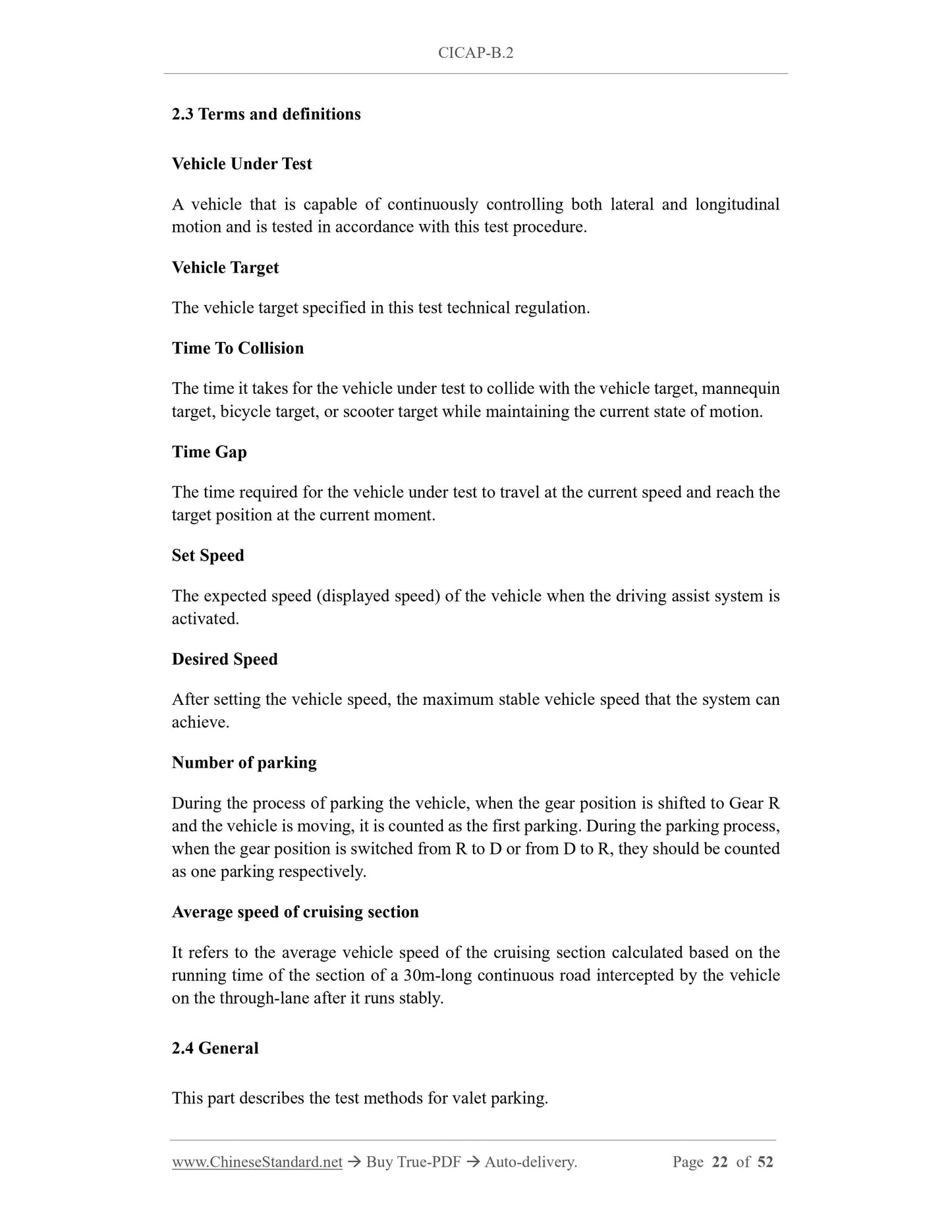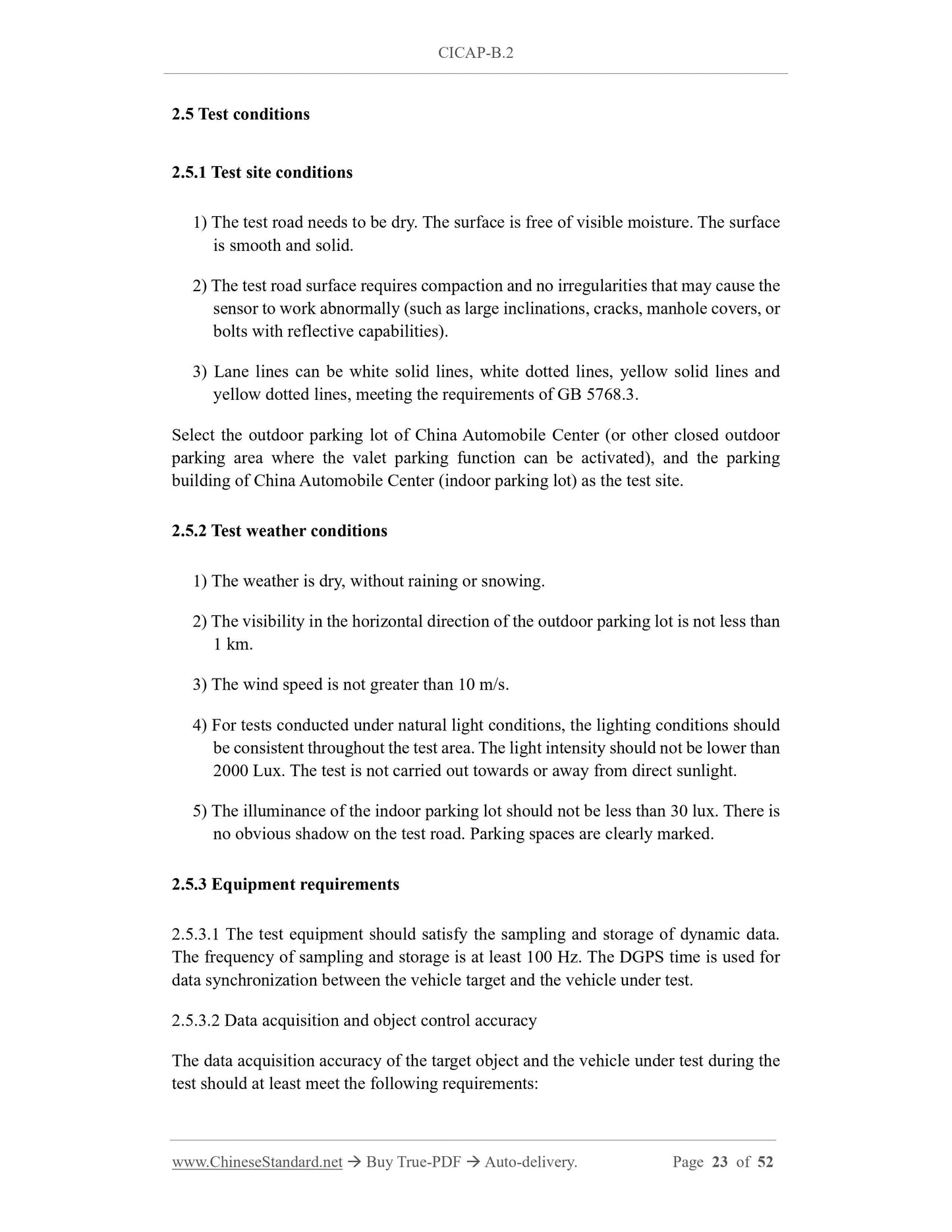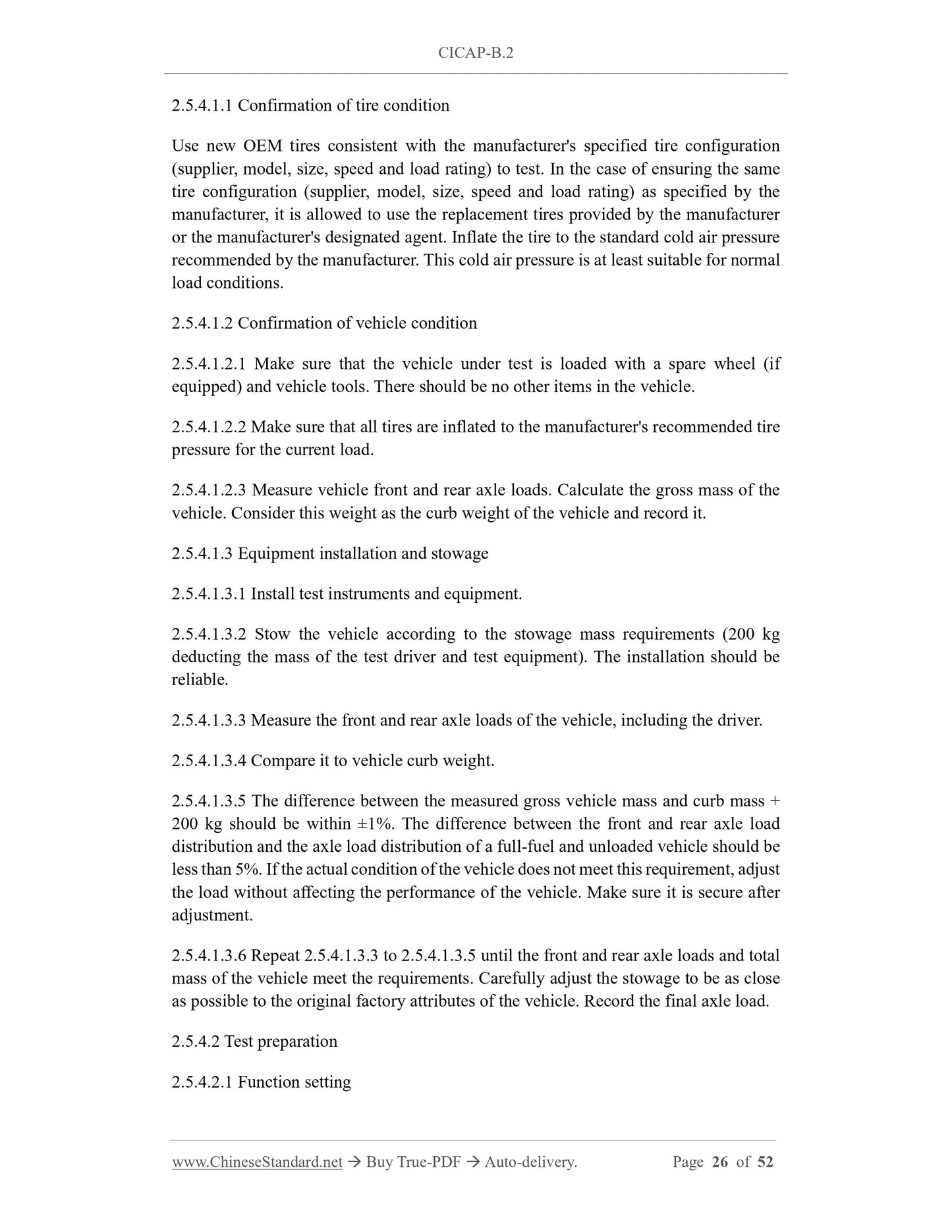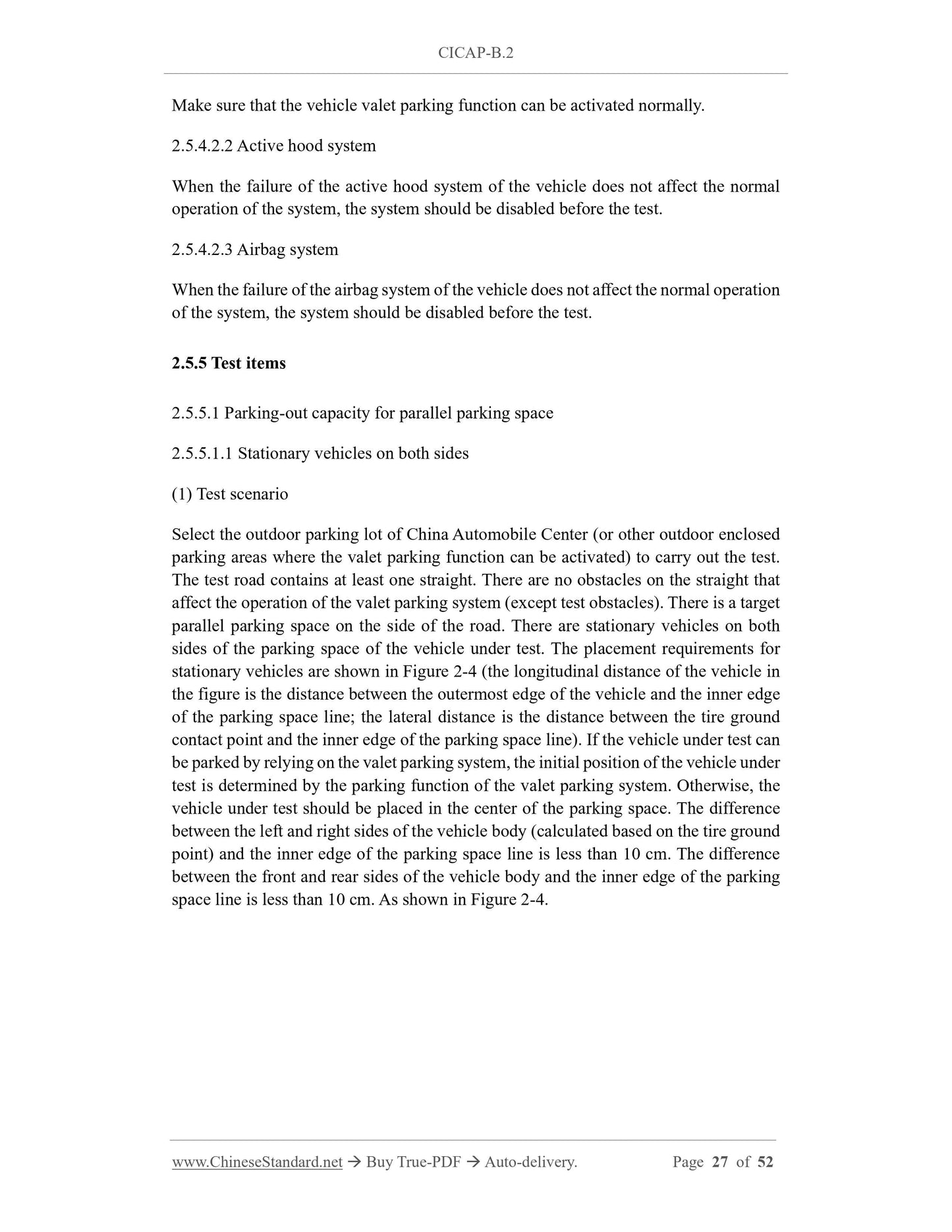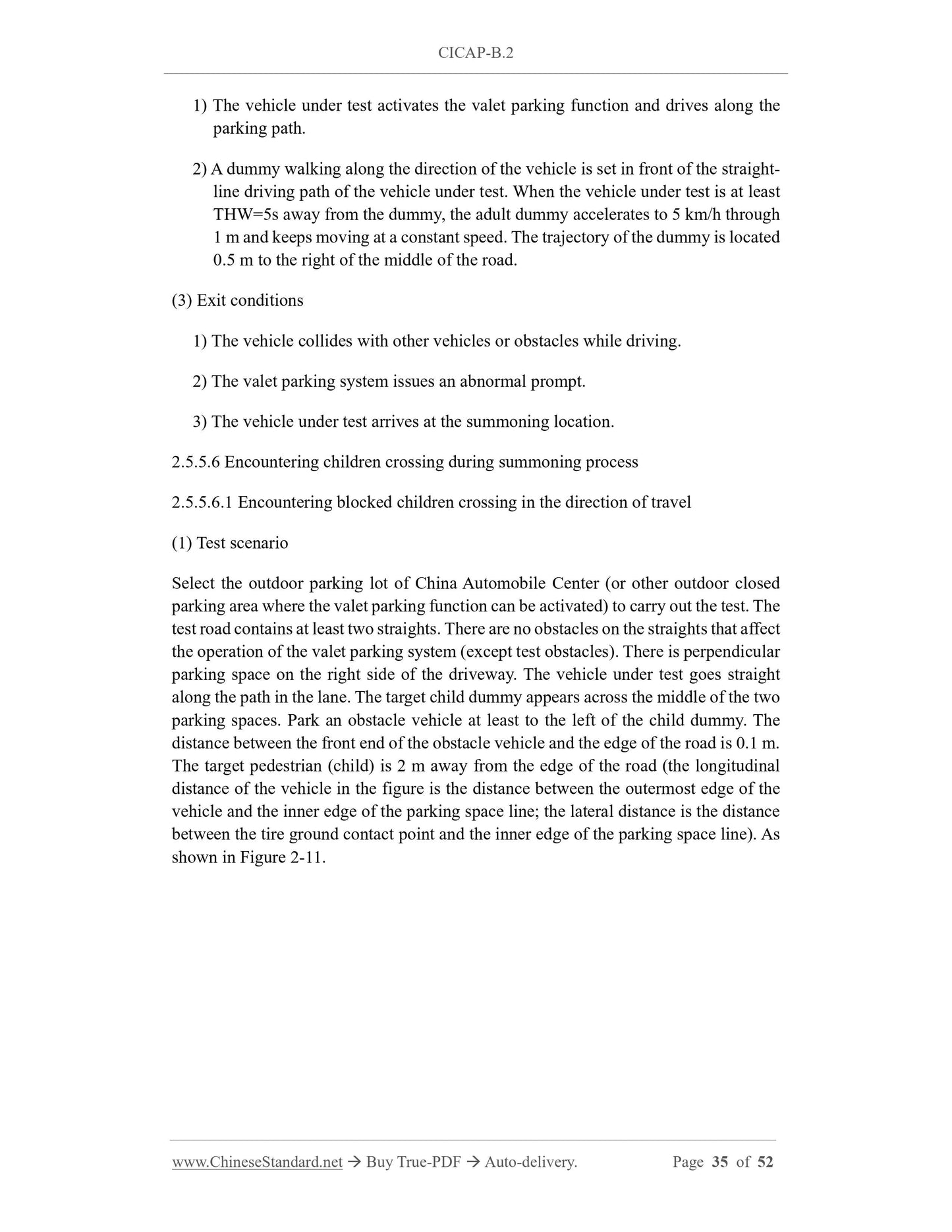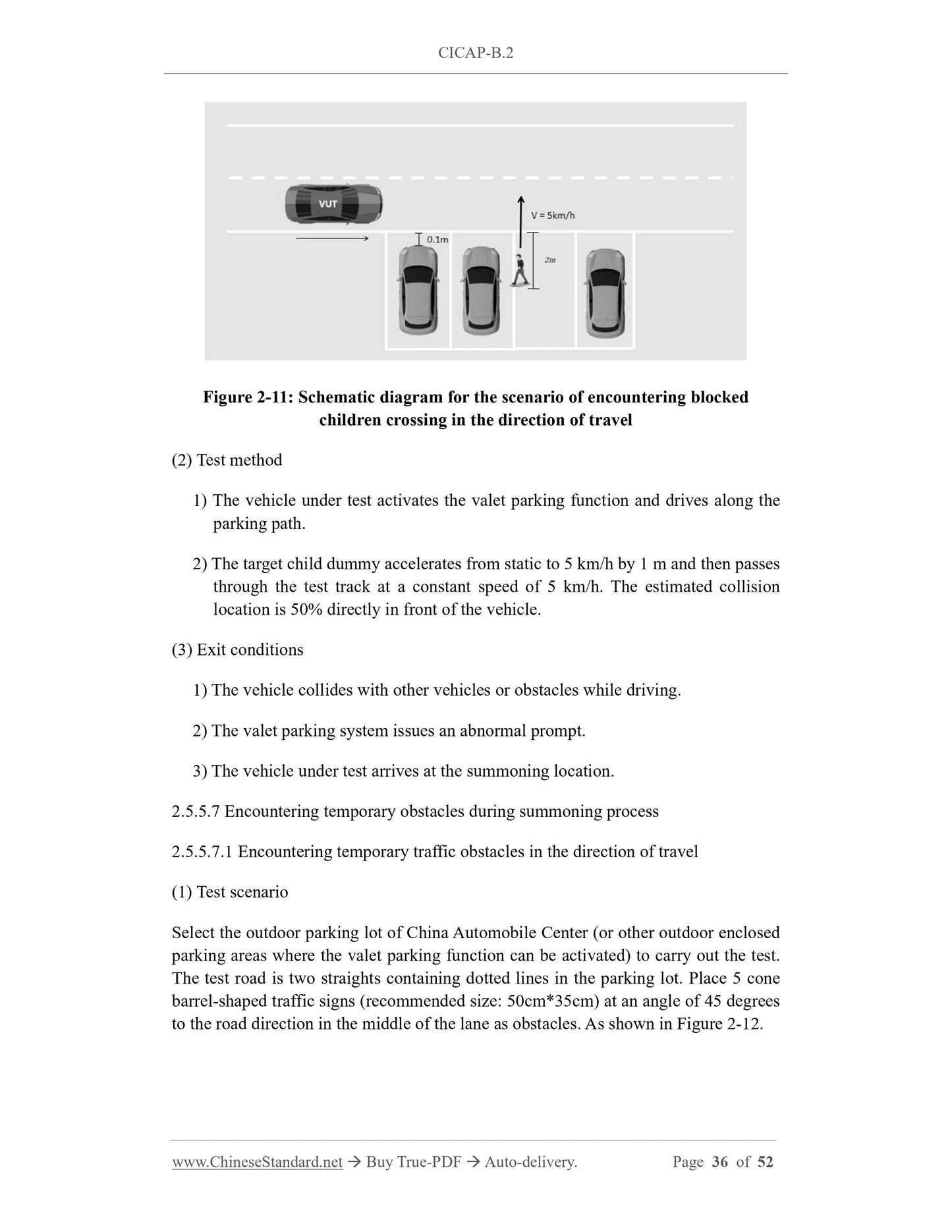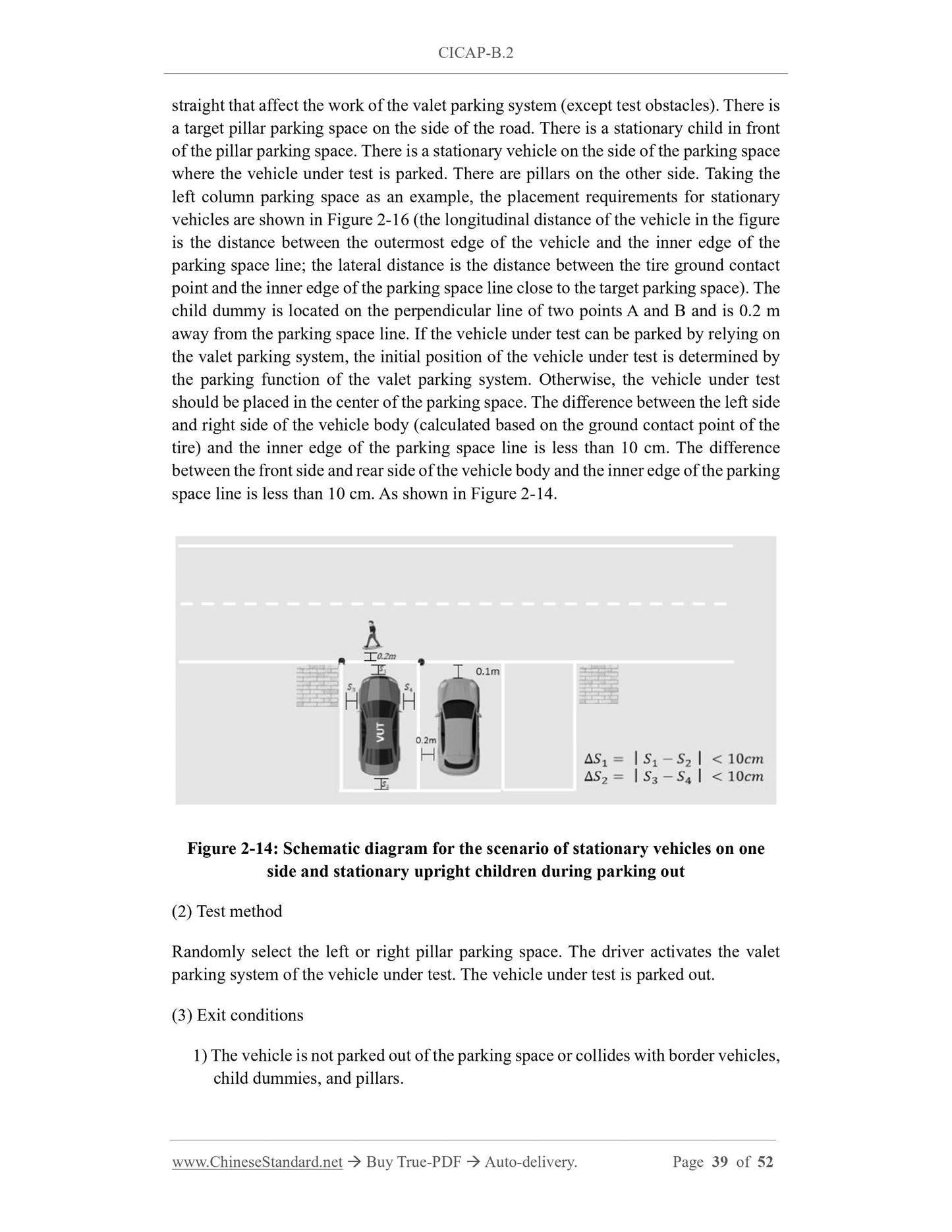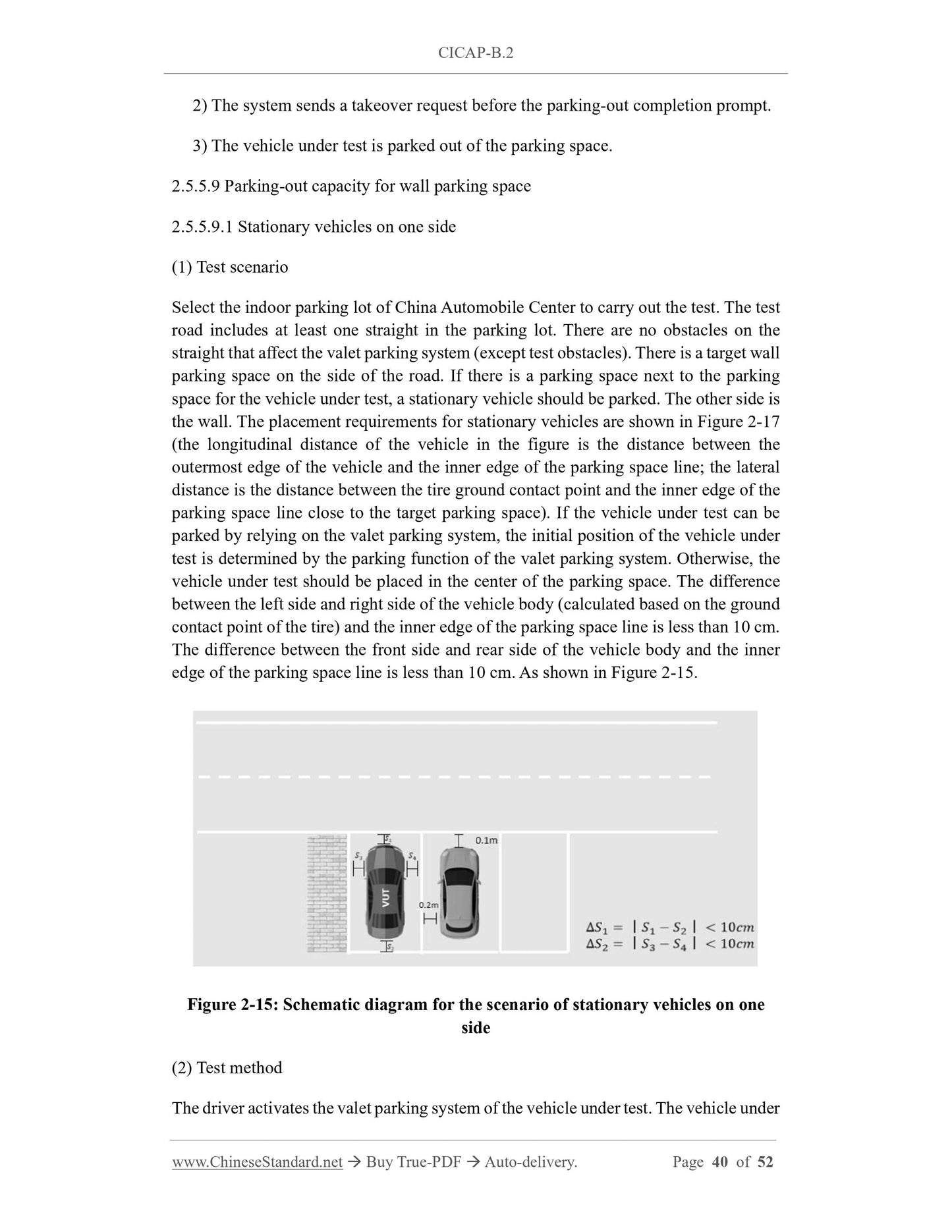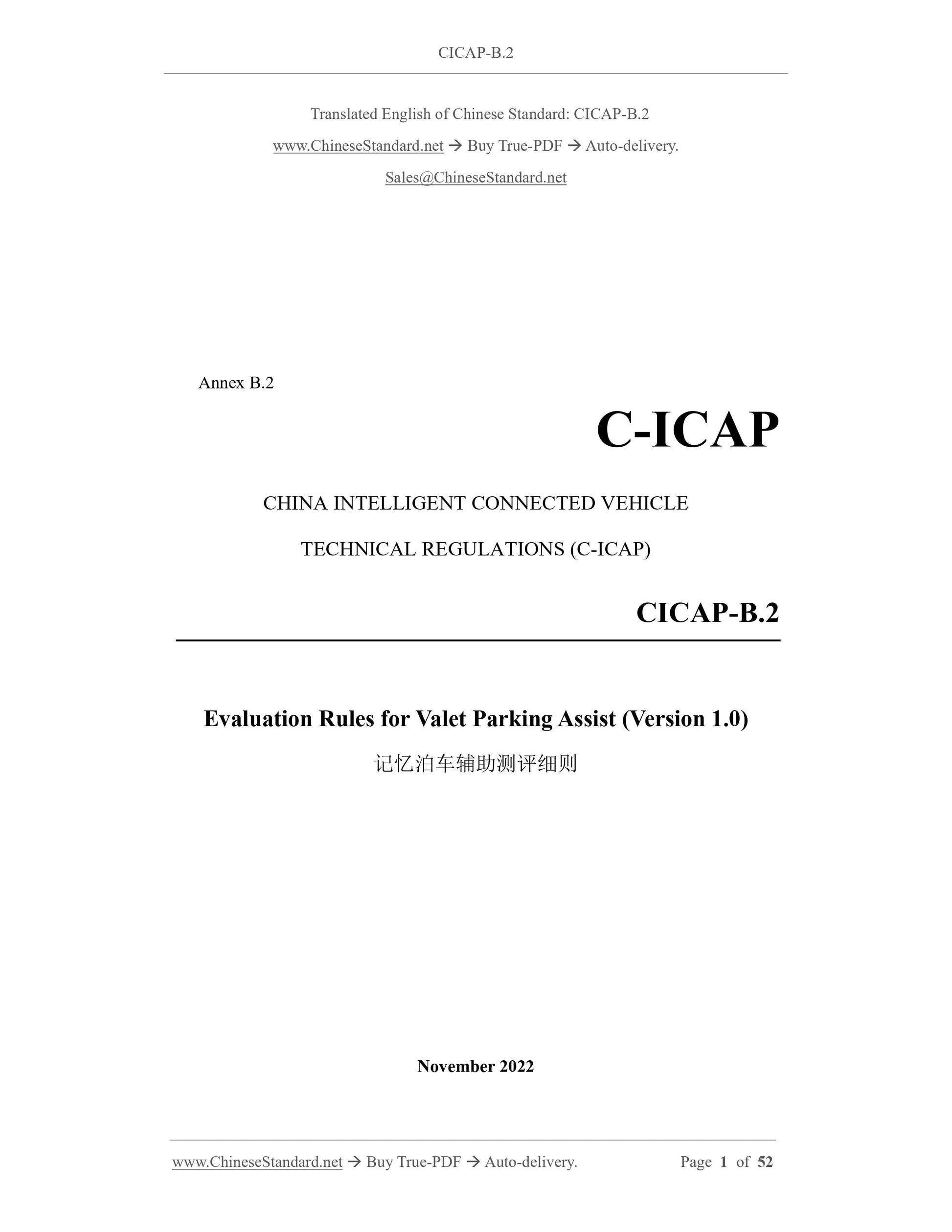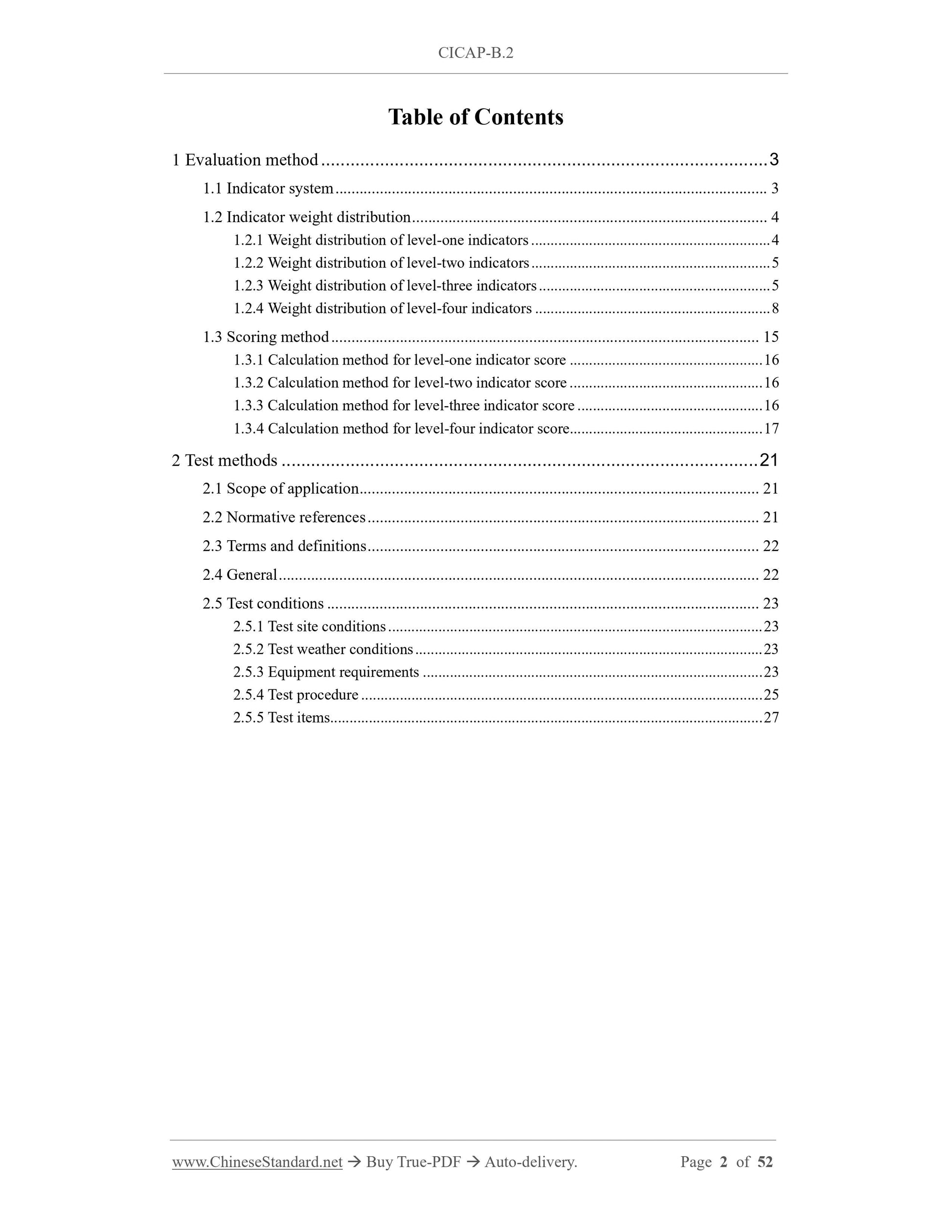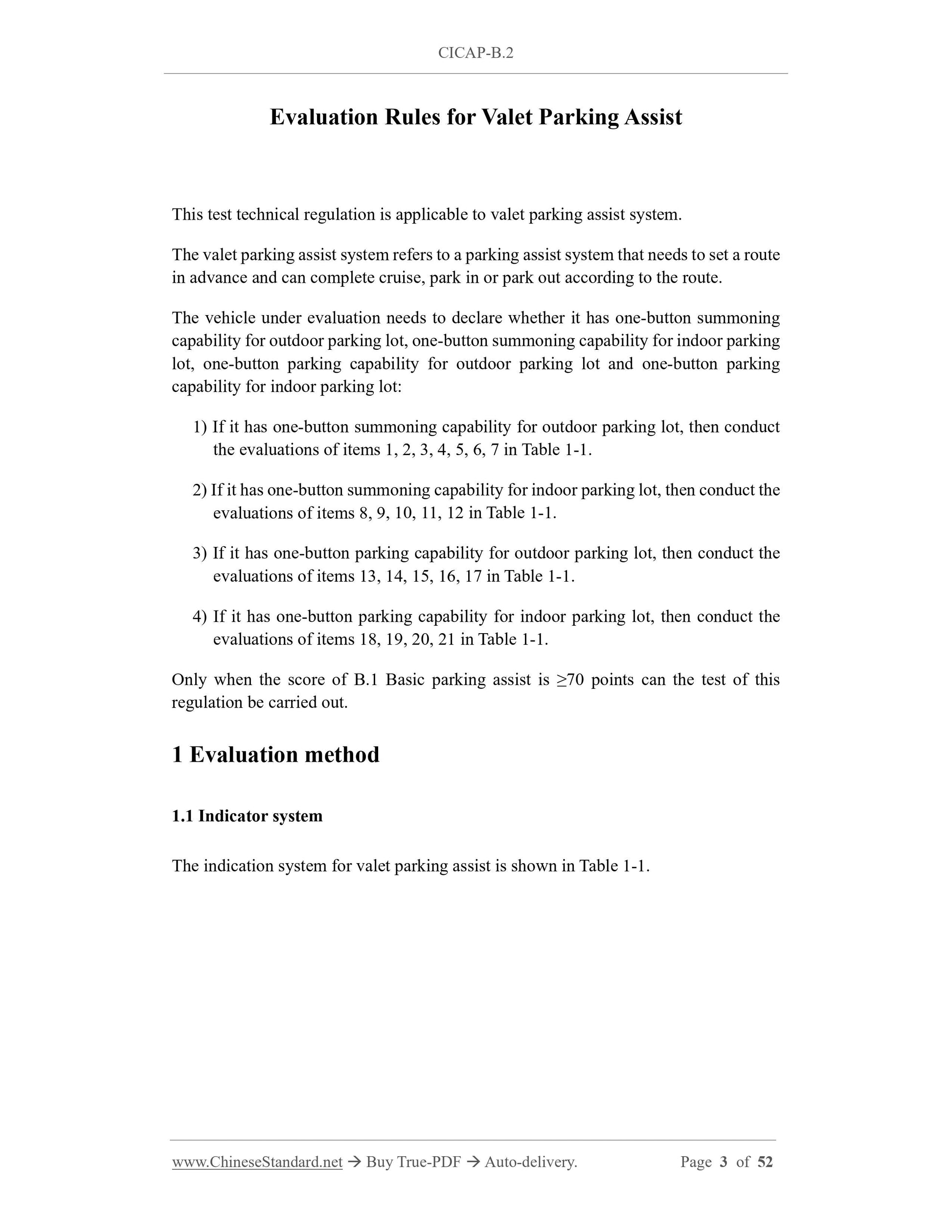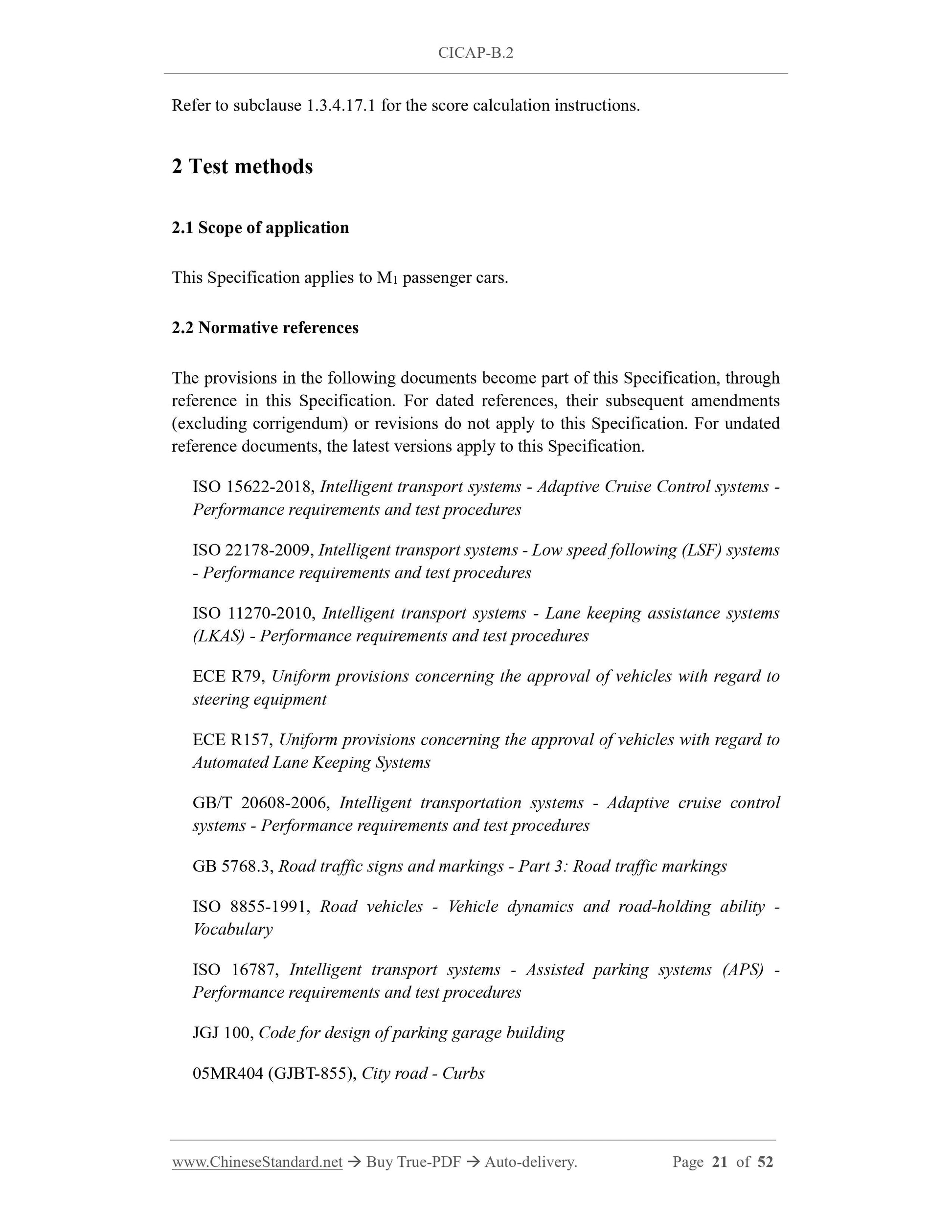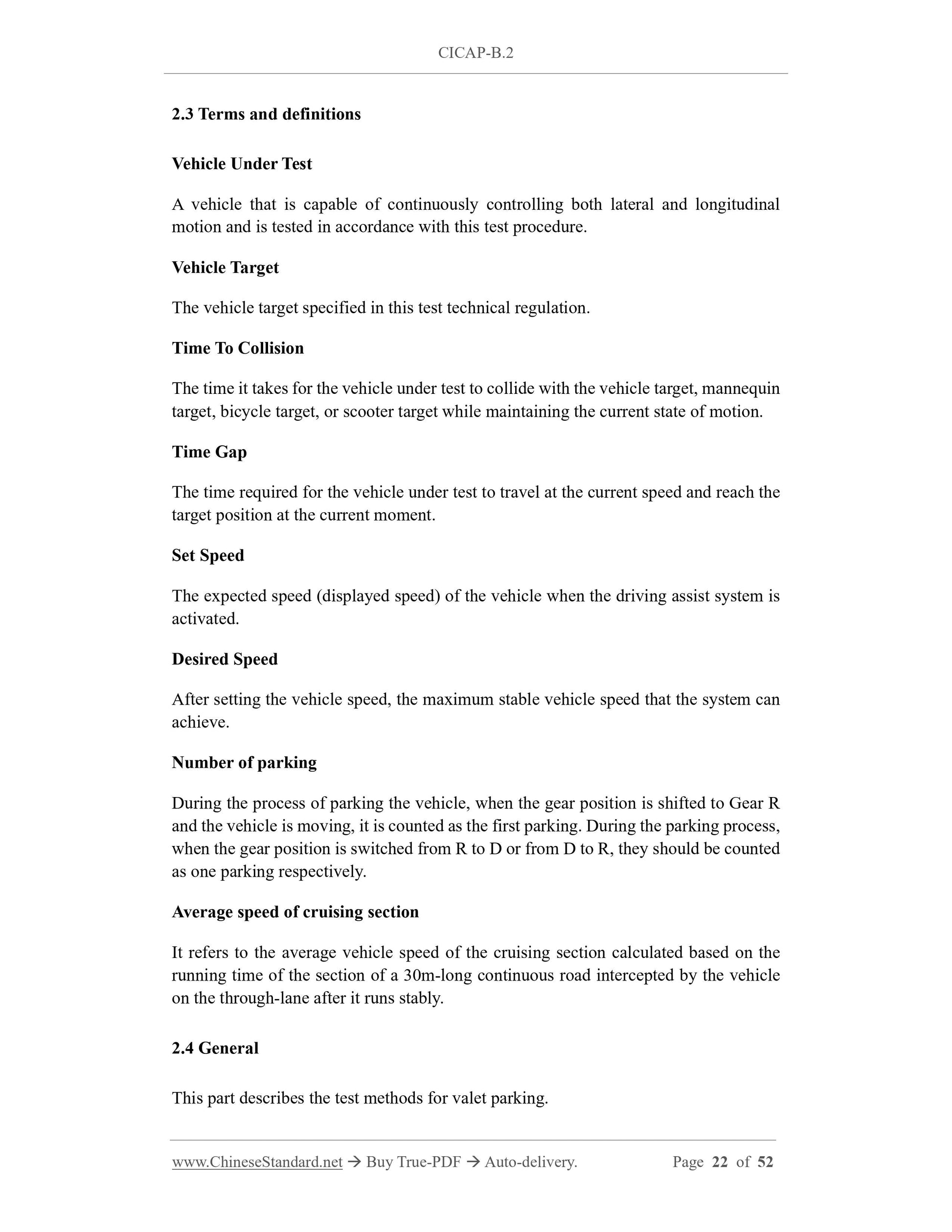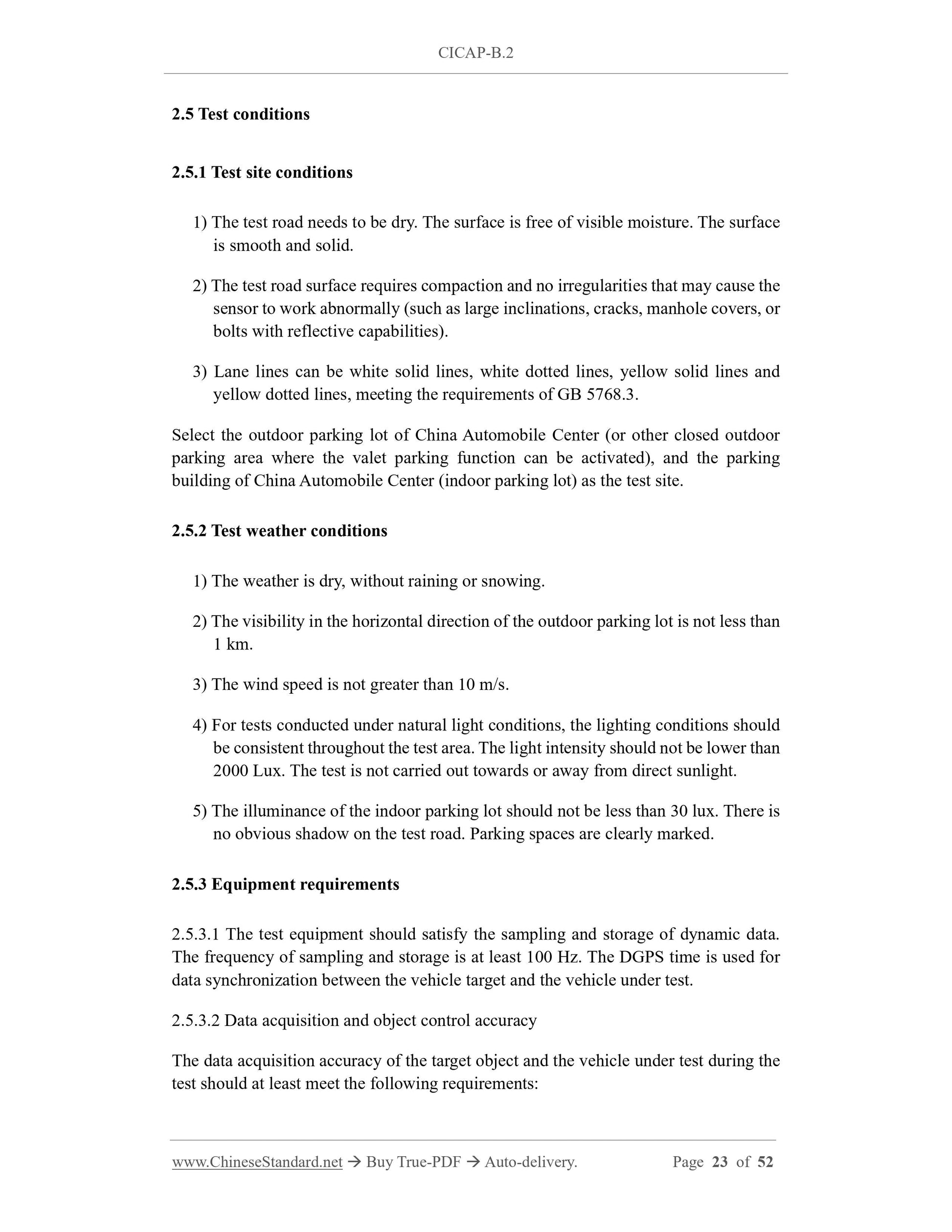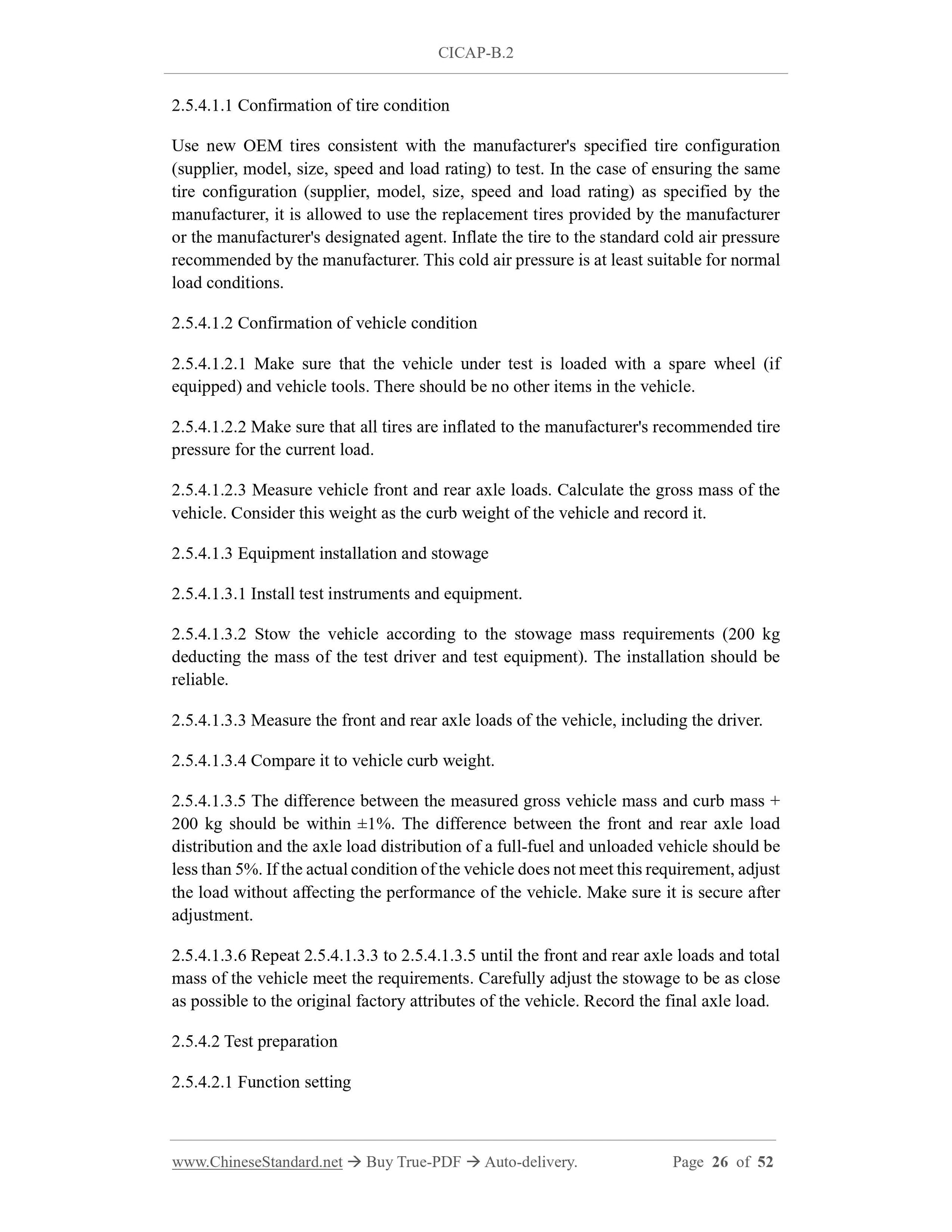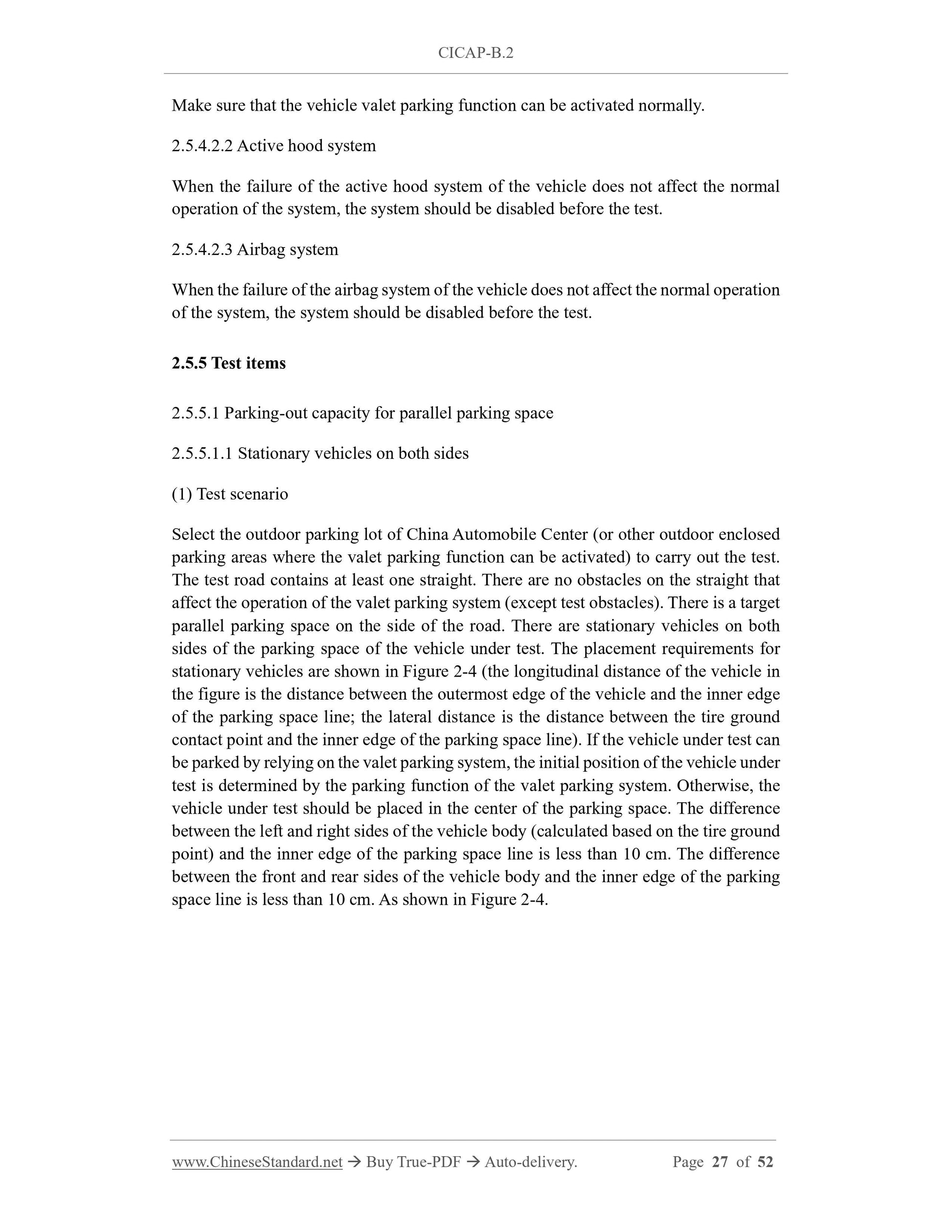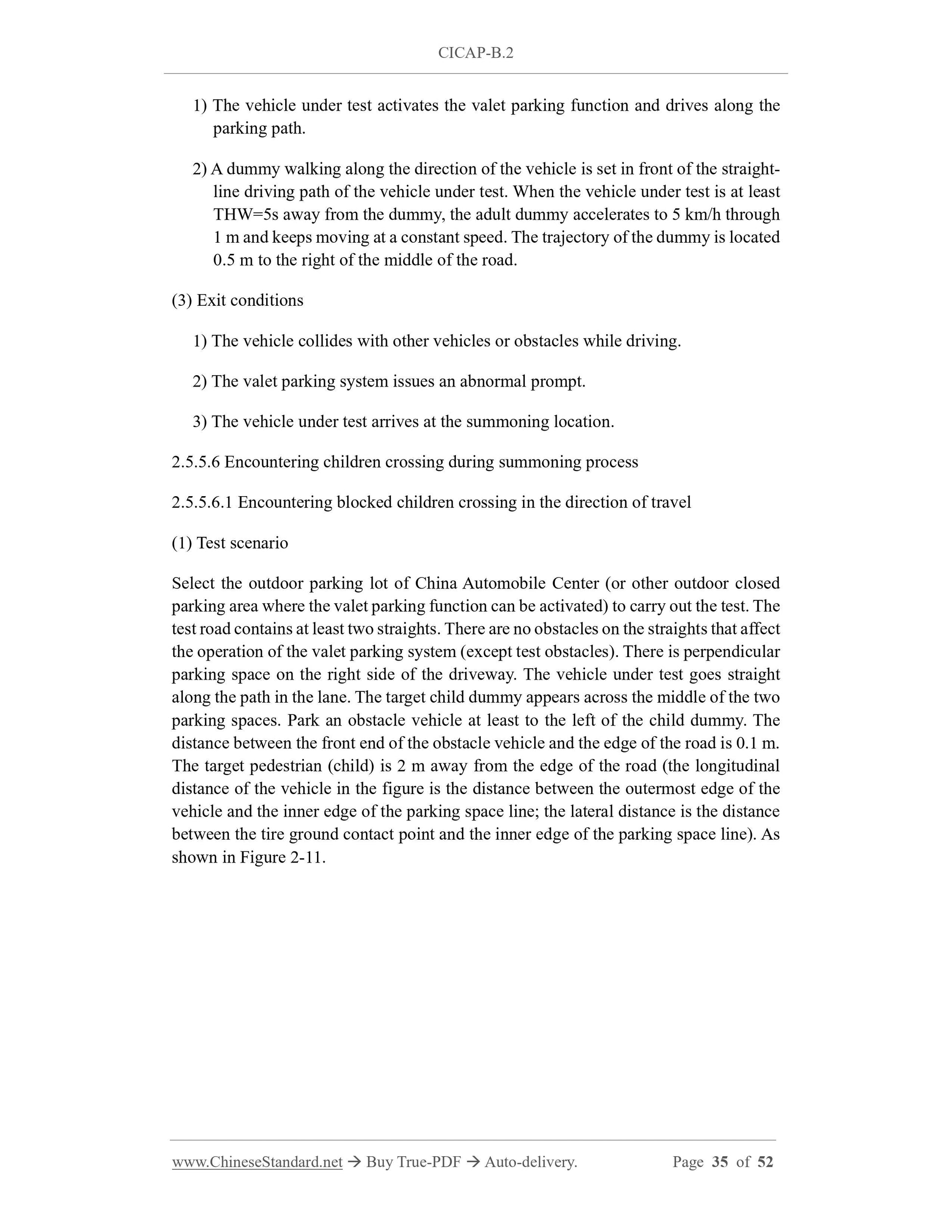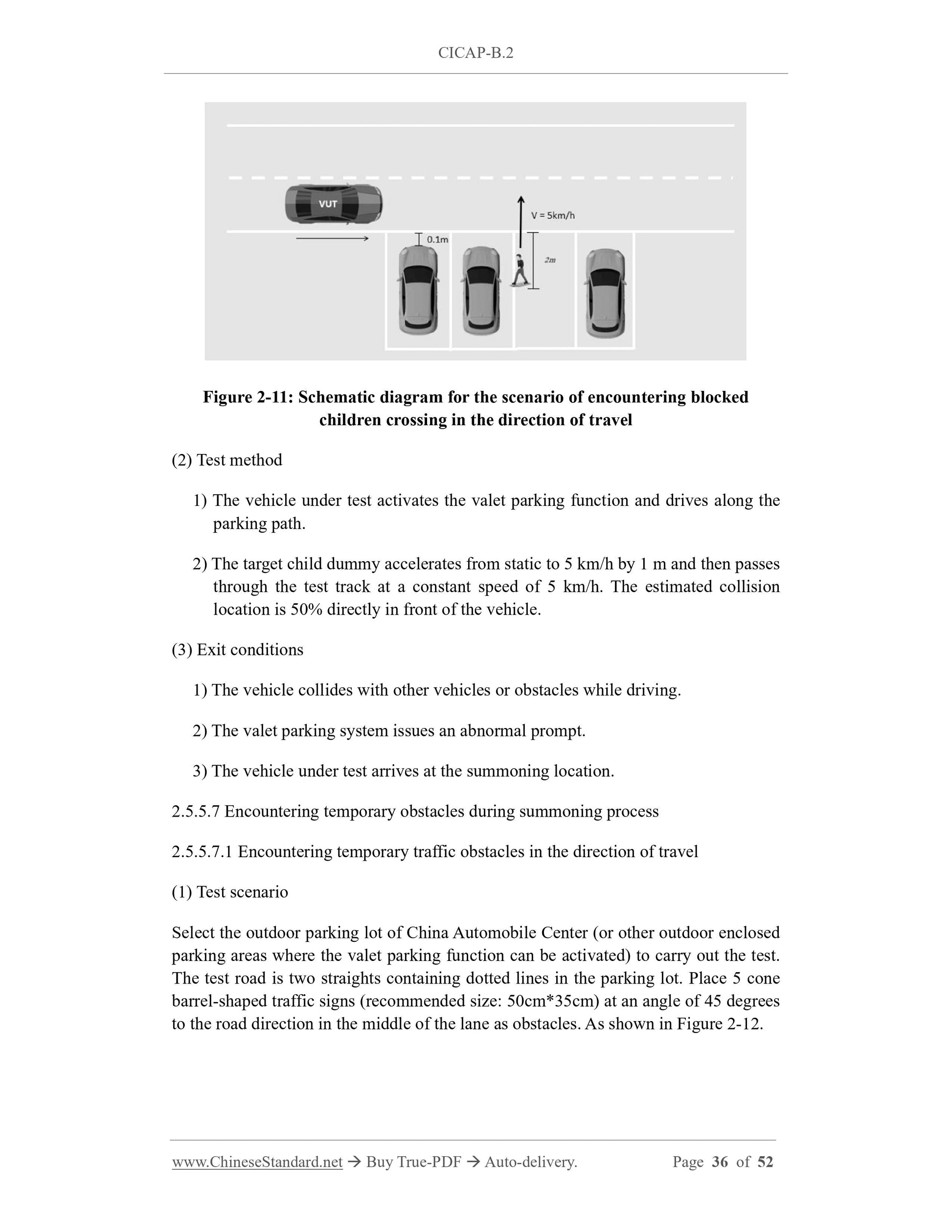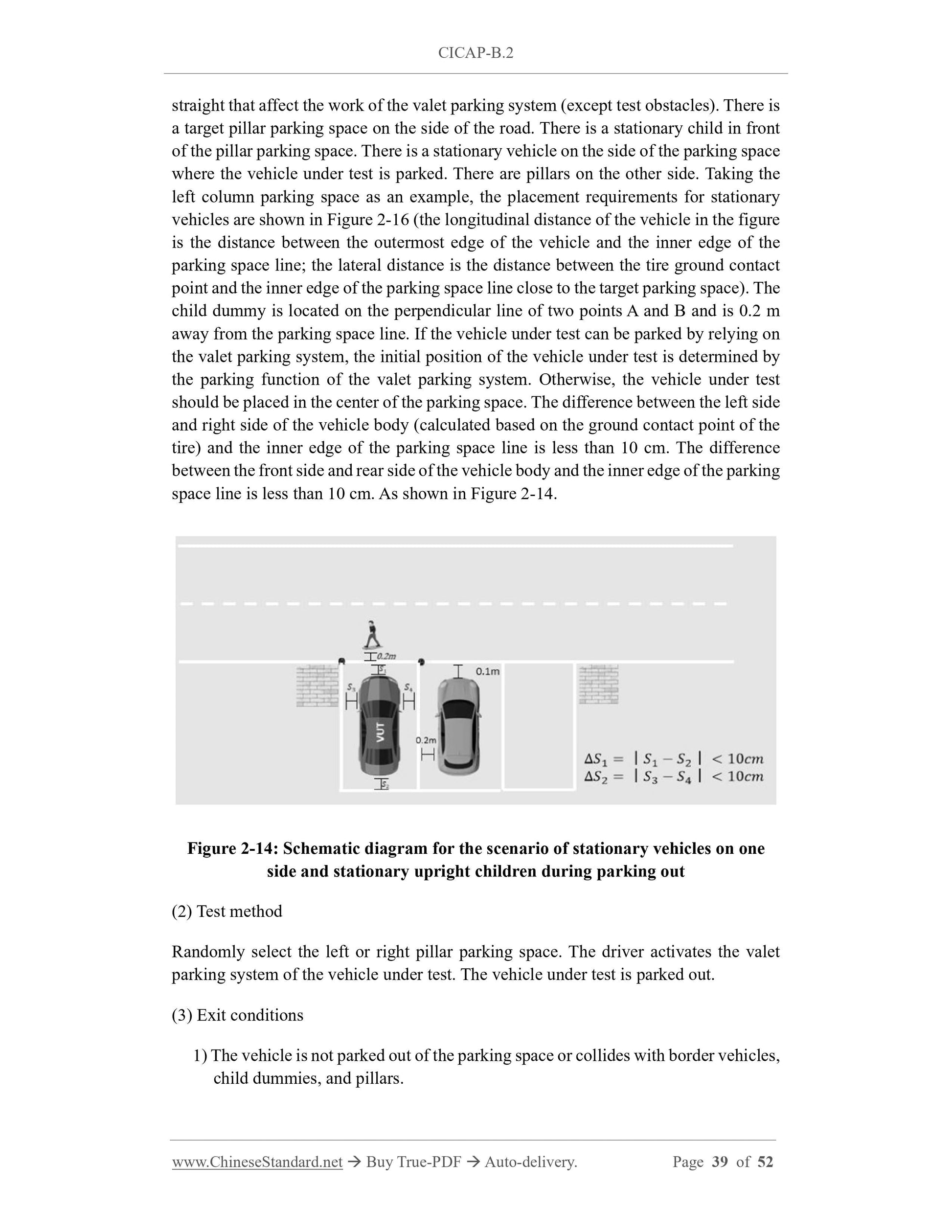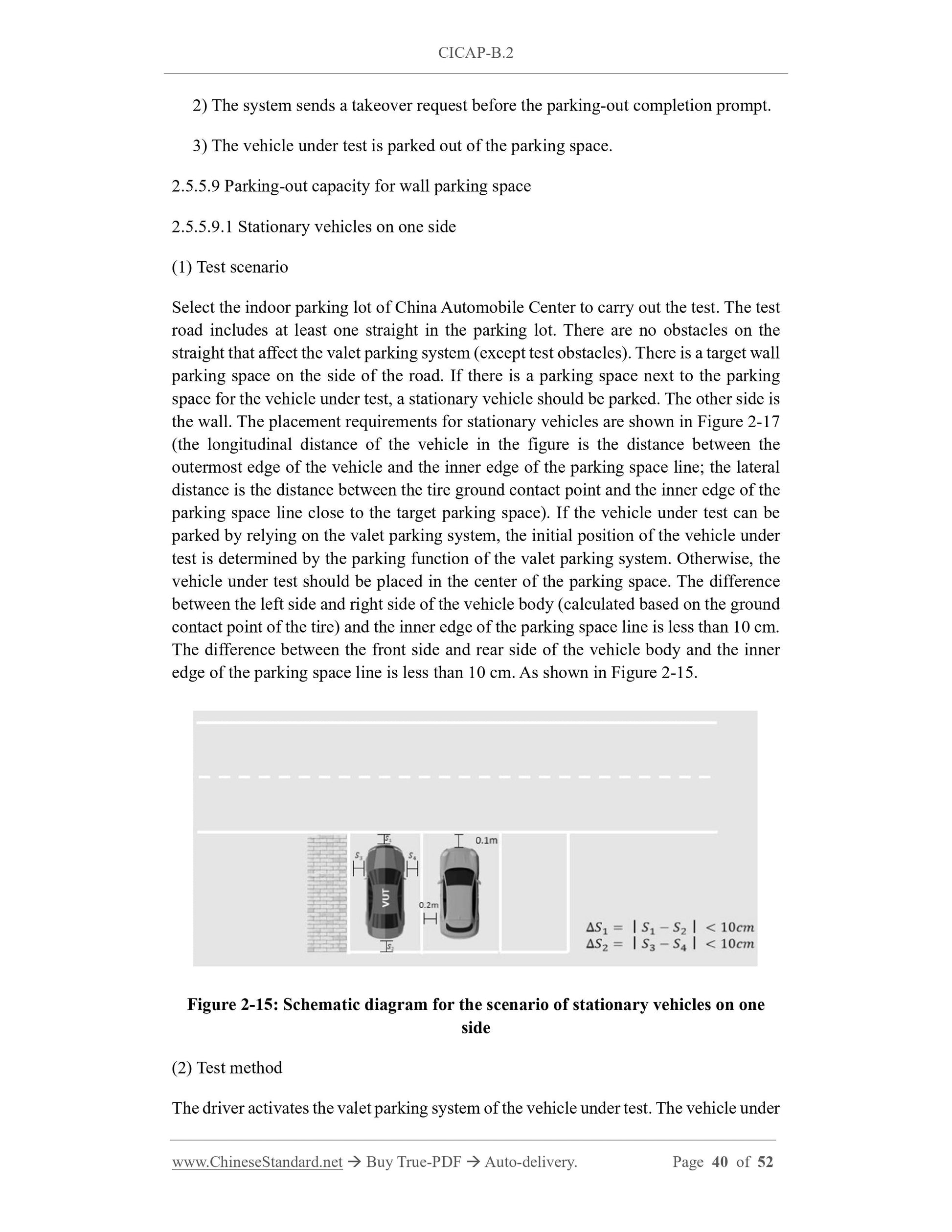PayPal, credit cards. Download editable-PDF & invoice In 1 second!
CICAP-B.2-2022 English PDF (CICAP-B.2-2022)
CICAP-B.2-2022 English PDF (CICAP-B.2-2022)
Precio habitual
$1,140.00 USD
Precio habitual
Precio de oferta
$1,140.00 USD
Precio unitario
/
por
Los gastos de envío se calculan en la pantalla de pago.
No se pudo cargar la disponibilidad de retiro
Delivery: 3 seconds. Download true-PDF + Invoice.
Get QUOTATION in 1-minute: Click CICAP-B.2-2022
Historical versions: CICAP-B.2-2022
Preview True-PDF (Reload/Scroll if blank)
CICAP-B.2-2022: China intelligent connected vehicle technical regulations - Appendix B.2: Memory parking assistance evaluation detailed-rules
CICAP-B.2
Annex B.2
C-ICAP
CHINA INTELLIGENT CONNECTED VEHICLE
TECHNICAL REGULATIONS (C-ICAP)
Evaluation Rules for Valet Parking Assist (Version 1.0)
November 2022
Table of Contents
1 Evaluation method ... 3
1.1 Indicator system ... 3
1.2 Indicator weight distribution ... 4
1.2.1 Weight distribution of level-one indicators ... 4
1.2.2 Weight distribution of level-two indicators ... 5
1.2.3 Weight distribution of level-three indicators ... 5
1.2.4 Weight distribution of level-four indicators ... 8
1.3 Scoring method ... 15
1.3.1 Calculation method for level-one indicator score ... 16
1.3.2 Calculation method for level-two indicator score ... 16
1.3.3 Calculation method for level-three indicator score ... 16
1.3.4 Calculation method for level-four indicator score... 17
2 Test methods ... 21
2.1 Scope of application ... 21
2.2 Normative references ... 21
2.3 Terms and definitions ... 22
2.4 General ... 22
2.5 Test conditions ... 23
2.5.1 Test site conditions ... 23
2.5.2 Test weather conditions ... 23
2.5.3 Equipment requirements ... 23
2.5.4 Test procedure ... 25
2.5.5 Test items... 27
Evaluation Rules for Valet Parking Assist
This test technical regulation is applicable to valet parking assist system.
The valet parking assist system refers to a parking assist system that needs to set a route
in advance and can complete cruise, park in or park out according to the route.
The vehicle under evaluation needs to declare whether it has one-button summoning
capability for outdoor parking lot, one-button summoning capability for indoor parking
lot, one-button parking capability for outdoor parking lot and one-button parking
capability for indoor parking lot:
1) If it has one-button summoning capability for outdoor parking lot, then conduct
the evaluations of items 1, 2, 3, 4, 5, 6, 7 in Table 1-1.
2) If it has one-button summoning capability for indoor parking lot, then conduct the
evaluations of items 8, 9, 10, 11, 12 in Table 1-1.
3) If it has one-button parking capability for outdoor parking lot, then conduct the
evaluations of items 13, 14, 15, 16, 17 in Table 1-1.
4) If it has one-button parking capability for indoor parking lot, then conduct the
evaluations of items 18, 19, 20, 21 in Table 1-1.
Only when the score of B.1 Basic parking assist is ≥70 points can the test of this
regulation be carried out.
1 Evaluation method
1.1 Indicator system
The indication system for valet parking assist is shown in Table 1-1.
Refer to subclause 1.3.4.17.1 for the score calculation instructions.
2 Test methods
2.1 Scope of application
This Specification applies to M1 passenger cars.
2.2 Normative references
The provisions in the following documents become part of this Specification, through
reference in this Specification. For dated references, their subsequent amendments
(excluding corrigendum) or revisions do not apply to this Specification. For undated
reference documents, the latest versions apply to this Specification.
ISO 15622-2018, Intelligent transport systems - Adaptive Cruise Control systems -
Performance requirements and test procedures
ISO 22178-2009, Intelligent transport systems - Low speed following (LSF) systems
- Performance requirements and test procedures
ISO 11270-2010, Intelligent transport systems - Lane keeping assistance systems
(LKAS) - Performance requirements and test procedures
ECE R79, Uniform provisions concerning the approval of vehicles with regard to
steering equipment
ECE R157, Uniform provisions concerning the approval of vehicles with regard to
Automated Lane Keeping Systems
GB/T 20608-2006, Intelligent transportation systems - Adaptive cruise control
systems - Performance requirements and test procedures
GB 5768.3, Road traffic signs and markings - Part 3: Road traffic markings
ISO 8855-1991, Road vehicles - Vehicle dynamics and road-holding ability -
Vocabulary
ISO 16787, Intelligent transport systems - Assisted parking systems (APS) -
Performance requirements and test procedures
JGJ 100, Code for design of parking garage building
05MR404 (GJBT-855), City road - Curbs
2.3 Terms and definitions
Vehicle Under Test
A vehicle that is capable of continuously controlling both lateral and longitudinal
motion and is tested in accordance with this test procedure.
Vehicle Target
The vehicle target specified in this test technical regulation.
Time To Collision
The time it takes for the vehicle under test to collide with the vehicle target, mannequin
target, bicycle target, or scooter target while maintaining the current state of motion.
Time Gap
The time required for the vehicle under test to travel at the current speed and reach the
target position at the current moment.
Set Speed
The expected speed (displayed speed) of the vehicle when the driving assist system is
activated.
Desired Speed
After setting the vehicle speed, the maximum stable vehicle speed that the system can
achieve.
Number of parking
During the process of parking the vehicle, when the gear position is shifted to Gear R
and the vehicle is moving, it is counted as the first parking. During the parking process,
when the gear position is switched from R to D or from D to R, they should be counted
as one parking respectively.
Average speed of cruising section
It refers to the average vehicle speed of the cruising section calculated based on the
running time of the section of a 30m-long continuous road intercepted by the vehicle
on the through-lane after it runs stably.
2.4 General
This part describes the test methods for valet parking.
2.5 Test conditions
2.5.1 Test site conditions
1) The test road needs to be dry. The surface is free of visible moisture. The surface
is smooth and solid.
2) The test road surface requires compaction and no irregularities that may cause the
sensor to work abnormally (such as large inclinations, cracks, manhole covers, or
bolts with reflective capabilities).
3) Lane lines can be white solid lines, white dotted lines, yellow solid lines and
yellow dotted lines, meeting the requirements of GB 5768.3.
Select the outdoor parking lot of China Automobile Center (or other closed outdoor
parking area where the valet parking function can be activated), and the parking
building of China Automobile Center (indoor parking lot) as the test site.
2.5.2 Test weather conditions
1) The weather is dry, without raining or snowing.
2) The visibility in the horizontal direction of the outdoor parking lot is not less than
1 km.
3) The wind speed is not greater than 10 m/s.
4) For tests conducted under natural light conditions, the lighting conditions should
be consistent throughout the test area. The light intensity should not be lower than
2000 Lux. The test is not carried out towards or away from direct sunlight.
5) The illuminance of the indoor parking lot should not be less than 30 lux. There is
no obvious shadow on the test road. Parking spaces are clearly marked.
2.5.3 Equipment requirements
2.5.3.1 The test equipment should satisfy the sampling and storage of dynamic data.
The frequency of sampling and storage is at least 100 Hz. The DGPS time is used for
data synchronization between the vehicle target and the vehicle under test.
2.5.3.2 Data acquisition and object control accuracy
The data acquisition accuracy of the target object and the vehicle under test during the
test should at least...
Get QUOTATION in 1-minute: Click CICAP-B.2-2022
Historical versions: CICAP-B.2-2022
Preview True-PDF (Reload/Scroll if blank)
CICAP-B.2-2022: China intelligent connected vehicle technical regulations - Appendix B.2: Memory parking assistance evaluation detailed-rules
CICAP-B.2
Annex B.2
C-ICAP
CHINA INTELLIGENT CONNECTED VEHICLE
TECHNICAL REGULATIONS (C-ICAP)
Evaluation Rules for Valet Parking Assist (Version 1.0)
November 2022
Table of Contents
1 Evaluation method ... 3
1.1 Indicator system ... 3
1.2 Indicator weight distribution ... 4
1.2.1 Weight distribution of level-one indicators ... 4
1.2.2 Weight distribution of level-two indicators ... 5
1.2.3 Weight distribution of level-three indicators ... 5
1.2.4 Weight distribution of level-four indicators ... 8
1.3 Scoring method ... 15
1.3.1 Calculation method for level-one indicator score ... 16
1.3.2 Calculation method for level-two indicator score ... 16
1.3.3 Calculation method for level-three indicator score ... 16
1.3.4 Calculation method for level-four indicator score... 17
2 Test methods ... 21
2.1 Scope of application ... 21
2.2 Normative references ... 21
2.3 Terms and definitions ... 22
2.4 General ... 22
2.5 Test conditions ... 23
2.5.1 Test site conditions ... 23
2.5.2 Test weather conditions ... 23
2.5.3 Equipment requirements ... 23
2.5.4 Test procedure ... 25
2.5.5 Test items... 27
Evaluation Rules for Valet Parking Assist
This test technical regulation is applicable to valet parking assist system.
The valet parking assist system refers to a parking assist system that needs to set a route
in advance and can complete cruise, park in or park out according to the route.
The vehicle under evaluation needs to declare whether it has one-button summoning
capability for outdoor parking lot, one-button summoning capability for indoor parking
lot, one-button parking capability for outdoor parking lot and one-button parking
capability for indoor parking lot:
1) If it has one-button summoning capability for outdoor parking lot, then conduct
the evaluations of items 1, 2, 3, 4, 5, 6, 7 in Table 1-1.
2) If it has one-button summoning capability for indoor parking lot, then conduct the
evaluations of items 8, 9, 10, 11, 12 in Table 1-1.
3) If it has one-button parking capability for outdoor parking lot, then conduct the
evaluations of items 13, 14, 15, 16, 17 in Table 1-1.
4) If it has one-button parking capability for indoor parking lot, then conduct the
evaluations of items 18, 19, 20, 21 in Table 1-1.
Only when the score of B.1 Basic parking assist is ≥70 points can the test of this
regulation be carried out.
1 Evaluation method
1.1 Indicator system
The indication system for valet parking assist is shown in Table 1-1.
Refer to subclause 1.3.4.17.1 for the score calculation instructions.
2 Test methods
2.1 Scope of application
This Specification applies to M1 passenger cars.
2.2 Normative references
The provisions in the following documents become part of this Specification, through
reference in this Specification. For dated references, their subsequent amendments
(excluding corrigendum) or revisions do not apply to this Specification. For undated
reference documents, the latest versions apply to this Specification.
ISO 15622-2018, Intelligent transport systems - Adaptive Cruise Control systems -
Performance requirements and test procedures
ISO 22178-2009, Intelligent transport systems - Low speed following (LSF) systems
- Performance requirements and test procedures
ISO 11270-2010, Intelligent transport systems - Lane keeping assistance systems
(LKAS) - Performance requirements and test procedures
ECE R79, Uniform provisions concerning the approval of vehicles with regard to
steering equipment
ECE R157, Uniform provisions concerning the approval of vehicles with regard to
Automated Lane Keeping Systems
GB/T 20608-2006, Intelligent transportation systems - Adaptive cruise control
systems - Performance requirements and test procedures
GB 5768.3, Road traffic signs and markings - Part 3: Road traffic markings
ISO 8855-1991, Road vehicles - Vehicle dynamics and road-holding ability -
Vocabulary
ISO 16787, Intelligent transport systems - Assisted parking systems (APS) -
Performance requirements and test procedures
JGJ 100, Code for design of parking garage building
05MR404 (GJBT-855), City road - Curbs
2.3 Terms and definitions
Vehicle Under Test
A vehicle that is capable of continuously controlling both lateral and longitudinal
motion and is tested in accordance with this test procedure.
Vehicle Target
The vehicle target specified in this test technical regulation.
Time To Collision
The time it takes for the vehicle under test to collide with the vehicle target, mannequin
target, bicycle target, or scooter target while maintaining the current state of motion.
Time Gap
The time required for the vehicle under test to travel at the current speed and reach the
target position at the current moment.
Set Speed
The expected speed (displayed speed) of the vehicle when the driving assist system is
activated.
Desired Speed
After setting the vehicle speed, the maximum stable vehicle speed that the system can
achieve.
Number of parking
During the process of parking the vehicle, when the gear position is shifted to Gear R
and the vehicle is moving, it is counted as the first parking. During the parking process,
when the gear position is switched from R to D or from D to R, they should be counted
as one parking respectively.
Average speed of cruising section
It refers to the average vehicle speed of the cruising section calculated based on the
running time of the section of a 30m-long continuous road intercepted by the vehicle
on the through-lane after it runs stably.
2.4 General
This part describes the test methods for valet parking.
2.5 Test conditions
2.5.1 Test site conditions
1) The test road needs to be dry. The surface is free of visible moisture. The surface
is smooth and solid.
2) The test road surface requires compaction and no irregularities that may cause the
sensor to work abnormally (such as large inclinations, cracks, manhole covers, or
bolts with reflective capabilities).
3) Lane lines can be white solid lines, white dotted lines, yellow solid lines and
yellow dotted lines, meeting the requirements of GB 5768.3.
Select the outdoor parking lot of China Automobile Center (or other closed outdoor
parking area where the valet parking function can be activated), and the parking
building of China Automobile Center (indoor parking lot) as the test site.
2.5.2 Test weather conditions
1) The weather is dry, without raining or snowing.
2) The visibility in the horizontal direction of the outdoor parking lot is not less than
1 km.
3) The wind speed is not greater than 10 m/s.
4) For tests conducted under natural light conditions, the lighting conditions should
be consistent throughout the test area. The light intensity should not be lower than
2000 Lux. The test is not carried out towards or away from direct sunlight.
5) The illuminance of the indoor parking lot should not be less than 30 lux. There is
no obvious shadow on the test road. Parking spaces are clearly marked.
2.5.3 Equipment requirements
2.5.3.1 The test equipment should satisfy the sampling and storage of dynamic data.
The frequency of sampling and storage is at least 100 Hz. The DGPS time is used for
data synchronization between the vehicle target and the vehicle under test.
2.5.3.2 Data acquisition and object control accuracy
The data acquisition accuracy of the target object and the vehicle under test during the
test should at least...
Share
